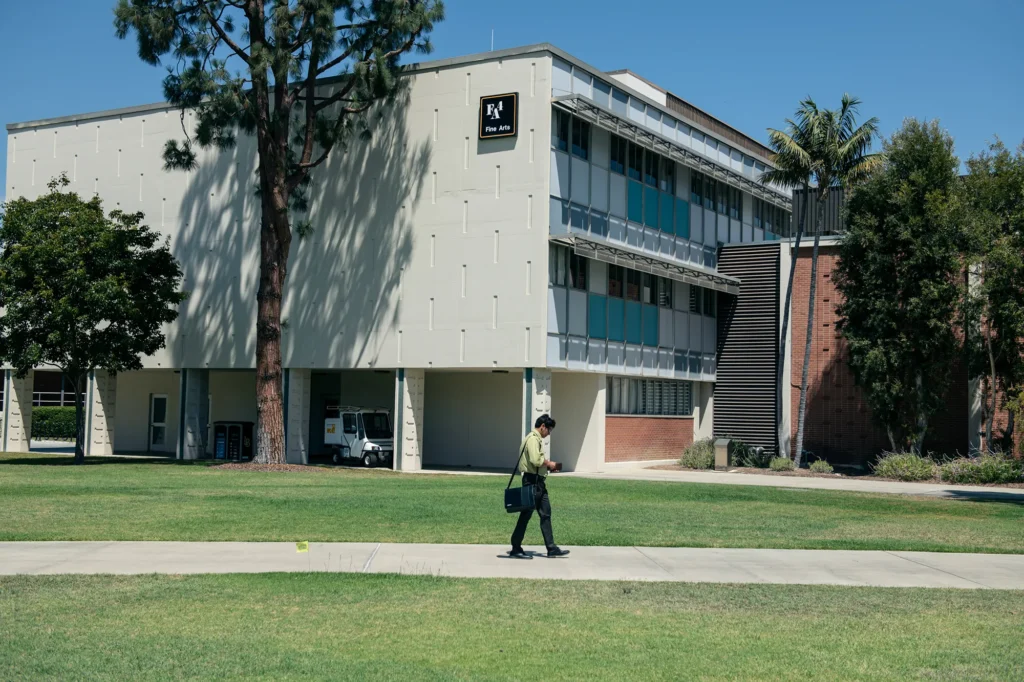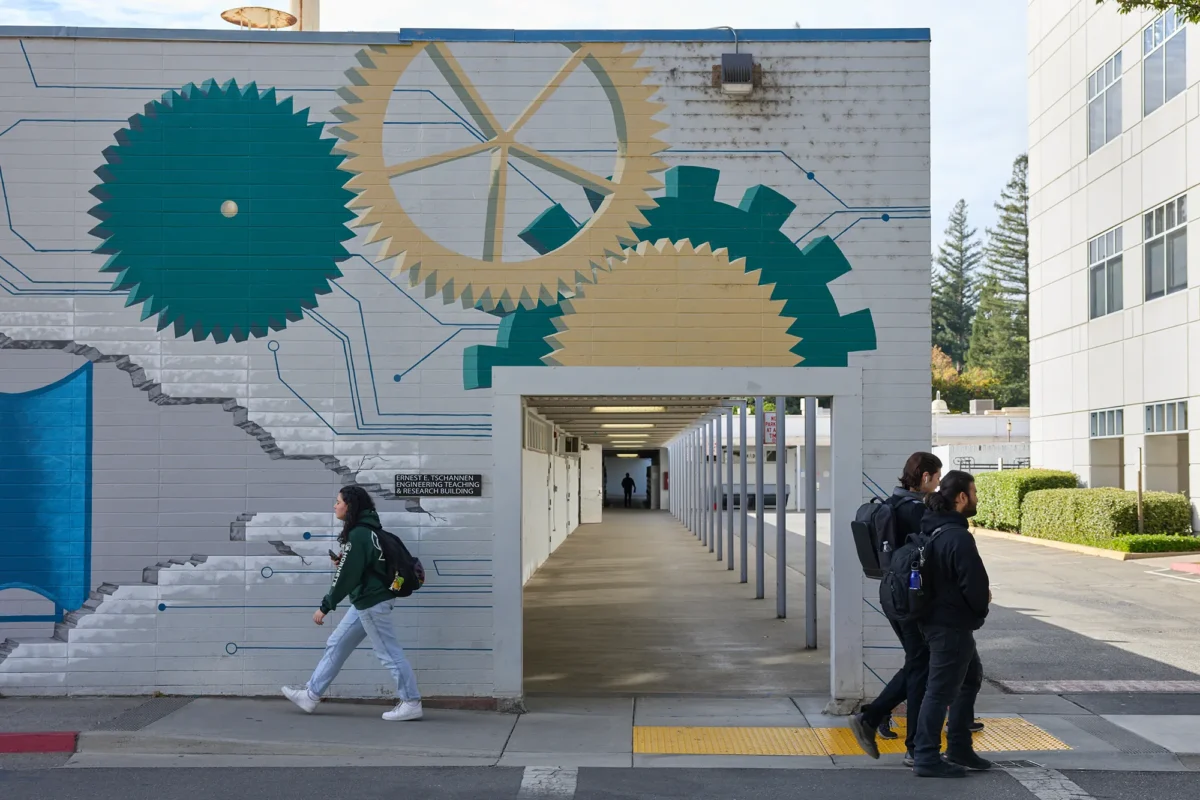This story was originally published by CalMatters. Sign up for their newsletters.
Aging buildings, failing infrastructure, earthquake safety issues, and a severe lack of campus housing are straining California’s public higher education systems. As they face high-cost fixes, lawmakers have introduced a bond bill that ambitiously intends to fund both the modernization of academic facilities and the addition of affordable student housing throughout the state.
The College Health and Safety Bond Act of 2026, AB 48, would start to address a growing $17 billion maintenance backlog within California’s university systems and the need for more affordable student housing in the state. The bill’s lead author, Assemblymember David Alvarez, a Democrat from San Diego, said it likely won’t include a dollar amount for the bond until it goes to the Senate next year to give the three public higher education systems in California time to report how much they need and a plan for spending it. If passed by the state Legislature, the bond would be placed on the November 2026 ballot for voters to decide.
If an education bond measure sounds familiar, here is why: In the November 2024 general election, Californians passed Proposition 2, which authorized $8.5 million in bonds for public K-12 schools and $1.5 billion for community colleges. Although lawmakers originally included the University of California and Cal State systems in the measure, they were later excluded to cap the total bond amount at $10 billion.
System leaders at the UC and Cal State were disappointed that they were removed from Proposition 2, according to previous reporting by CalMatters. The last time Cal State and UC benefited from a bond measure was in 2006, when both systems shared $3.1 billion for facility repairs and upgrades. Those funds were exhausted by 2012.
University buildings are in bad shape
A 2025 report by the Legislative Analyst’s Office shows that public higher education facilities are aging, campuses have growing maintenance needs, and their conditions are generally poor.
The backlog of repairs needed for the system’s facilities, known as deferred maintenance, has led to such issues as extreme indoor heat, outdated roofs and electrical problems. Since 2015, the state has provided deferred maintenance funding of just $689 million for UC, $784 million for Cal State, and an estimated $904 million for community colleges, according to the report.
However, CalMatters’ reporting found the UC and Cal State systems would need around $9 billion each to address their deferred maintenance needs. Community colleges have nearly $2.2 billion in maintenance needs in their current five-year plan, according to Chris Ferguson, the executive vice chancellor overseeing the finance and facilities division.
Some of the bond bill’s objectives are to prioritize safety issues and seismic deficiencies. Roughly 30% of UC and Cal State buildings and 20% of community college buildings were constructed before 1970.
According to the Cal State system’s current five-year plan, priority projects include replacing Peterson Hall 1 at Cal State Long Beach, which currently houses health sciences and is on the priority list for not meeting California’s building codes for earthquake safety. The building would consolidate other programs and replace two faculty office buildings from the 1950s, according to Paul Gannoe, an assistant vice chancellor in Cal State’s business and finance division.
Cal State also plans to replace Sacramento State’s engineering building, Santa Clara Hall. The infrastructure of the building, built in the 1960s, has exceeded its useful life, according to Cal State’s previous five-year plan.

The UC system’s six-year capital plan lists seismic safety, student housing, and facility restoration as its top goals. UC Berkeley, which opened in 1868, reports its highest priority for new funding is to add an academic building to house mathematics, economics, and other departments, moving them out of seismically unfit spaces. The campus also has plans for three future student housing projects.
At UC Davis, a $68 million improvement plan for the 86-year-old Hickey Gymnasium Building is on the unfunded priority list. One faculty member there, Carolynn Patten, has had to halt her stroke research due to rats chewing on cables and the extreme indoor heat compromising her equipment, she previously told CalMatters.
Although community colleges already are receiving funding for facilities from Proposition 2, Assemblymember Alvarez said they are included in this new bill because their needs are still significant and they are important to the entire ecosystem of higher education.
“In order to maintain our competitiveness as a state, we need to make sure we’re always investing in education, and we need to have the right facilities to do so,” Alvarez said. “A very large percentage of our buildings and our universities and colleges are outdated, and technology has advanced, and so we make sure we have the right types of learning environments.”
Student housing needs are also on the rise
Despite California’s generous financial aid programs, Kevin Cook from the Public Policy Institute of California said that due to the high cost of living in the state, trying to house students is an increasingly expensive task.
The average housing cost for independent students ranges from $1,400 to $1,520 per month, according to the California Student Aid Commission’s 2023 Food and Housing Survey, which surveyed students who applied for financial aid for the 2022-23 academic year. The same survey found that 53% of student respondents experienced housing insecurity.
A separate 2020 study by the Center for the Transformation of Schools at UCLA found that about 1 in 5 community college students, 1 in 10 Cal State students, and 1 in 20 UC students experience homelessness. Although the Legislative Analyst’s Office warns of limitations on both of these surveys, it does point out the noteworthiness of the number of students experiencing housing insecurity and homelessness.
The location of a campus can greatly impact student housing costs. The U.S. Department of Housing and Urban Development reported that the average off-campus rent for two-bedroom apartments near UC Merced was $1,465 per month in 2024, while for UC Santa Cruz it was $4,297 per month.
For Cal State students, the average rent per month for a two-bedroom apartment is $1,807 near Cal State Bakersfield, while the average is $3,014 per month near San Francisco State.
Aditi Hariharan, president of the UC Student Association, said the bond bill aligns with the association’s priorities, though they have not yet taken an official vote on whether to support the bill.
“Students are constantly struggling to stay in university and be enrolled, find housing, and that’s a significant cost of living barrier,” Hariharan said.
Chris Chandler, vice president of the Student Senate for California Community Colleges, said his association supports the bill because they understand how important housing is for their student body. Chandler is studying business administration at Southwestern College in Chula Vista, where students struggle to find affordable housing.
“You might hear students say, ‘Well, you know, I’m couch surfing with a friend’, or, ‘I’m about that van life’ and things like that,” Chandler said. “But you know, if we’re being really fair, those are homeless students, and they’re just looking for alternatives, to find a place where they can lay their head at night.”
Southwestern College does not offer on-campus housing to its students. However, 14 out of 116 California Community Colleges do. The proposed bond funding would help community colleges continue to develop affordable housing for students.
Facilities funding has evolved for universities
Traditionally, funding for university facilities has come from two sources: The state budget, for funding academic buildings such as classrooms, labs and faculty offices, and fees charged by the universities for self-supported facilities, such as housing, parking and campus dining.
In 2013 and 2014, in an effort to reduce state debt, then-Gov. Jerry Brown gave the UC and Cal State systems the authority to issue their own bonds. The university systems began selling revenue bonds to fund facility projects.
For revenue-generating projects such as student housing, universities use the proceeds from the bond as well as fees and rent paid by students to repay the bond and interest, said Robert Eaton, an assistant vice chancellor in Cal State’s business and finance division.
Academic facilities, such as a science building, do not generate revenue and have to be repaid through the system’s central budget. While Cal State trustees have the ability to set aside funds to service debt, they haven’t done so since 2018 due to an inadequate budget, Eaton said.
About five years ago, as housing and construction costs were sharply increasing, the state decided to start putting money toward affordable student housing. In 2021, the state Legislature approved allocating $2 billion over three years to public colleges and universities for the construction and renovation of student housing through the Higher Education Student Housing Grant. Gov. Gavin Newsom then took back that funding in 2023 to help close a state budget deficit, with the state instead agreeing to pay the principal and interest on bonds the colleges and universities issued themselves. That saved projects already in the works, but the state’s community colleges and public university systems still have many more student housing plans in need of funding.
A statewide bond that would fund both academic facilities and affordable student housing would address both deficits troubling California’s public higher education systems. However, the inclusion of student housing in the bond bill is “a big departure from historic state practice, and it’s raising a new tension with how to deal with academic facilities and improving the condition of those facilities, while also addressing student and faculty housing needs,” said Jennifer Pacella of the Legislative Analyst’s Office.
Would a bond have a chance with California voters?
According to the Legislative Analyst’s Office report, voters approve most state bonds for higher education facilities. From 1986 to 2016, voters approved 10 out of 12 state bond measures that benefited higher education. The only higher education bond measure to fail in the past 30 years was in 2020, when voters rejected Proposition 13, a $15 billion bond measure for K-12 schools, community colleges and universities.
The Howard Jarvis Taxpayers Association opposed that bond, and now opposes the new bill’s proposal. Susan Shelley, a spokesperson for the association, says that she looks at it from the perspective of the taxpayers who will be paying for the interest rate of the bond.
“Every couple of years, there’s a request for another bond to be added on top of that,” Shelley said. “We want to make sure that bonds are always funding something that will still be giving value to the people who are paying for it 30 years from now, and that it’s not just being used for current expenses or maintenance expenses or anything that won’t give value to the people who have to pay for it.”
Darien Shanske, professor of law at UC Davis, argues that the state subsidizing the cost of public education is a good investment. Although a state bond initiative would need public polling to determine its ability to pass, “there seems to be a fair amount of support for public higher education,” Shanske said.
An August 2025 poll by UC Berkeley’s Institute of Governmental Studies shows that out of 6,474 registered California voters who responded, 58% believe state funding should be increased for the UC system.
Mercy Sosa is a contributor with the College Journalism Network, a collaboration between CalMatters and student journalists from across California. CalMatters higher education coverage is supported by a grant from the College Futures Foundation.

